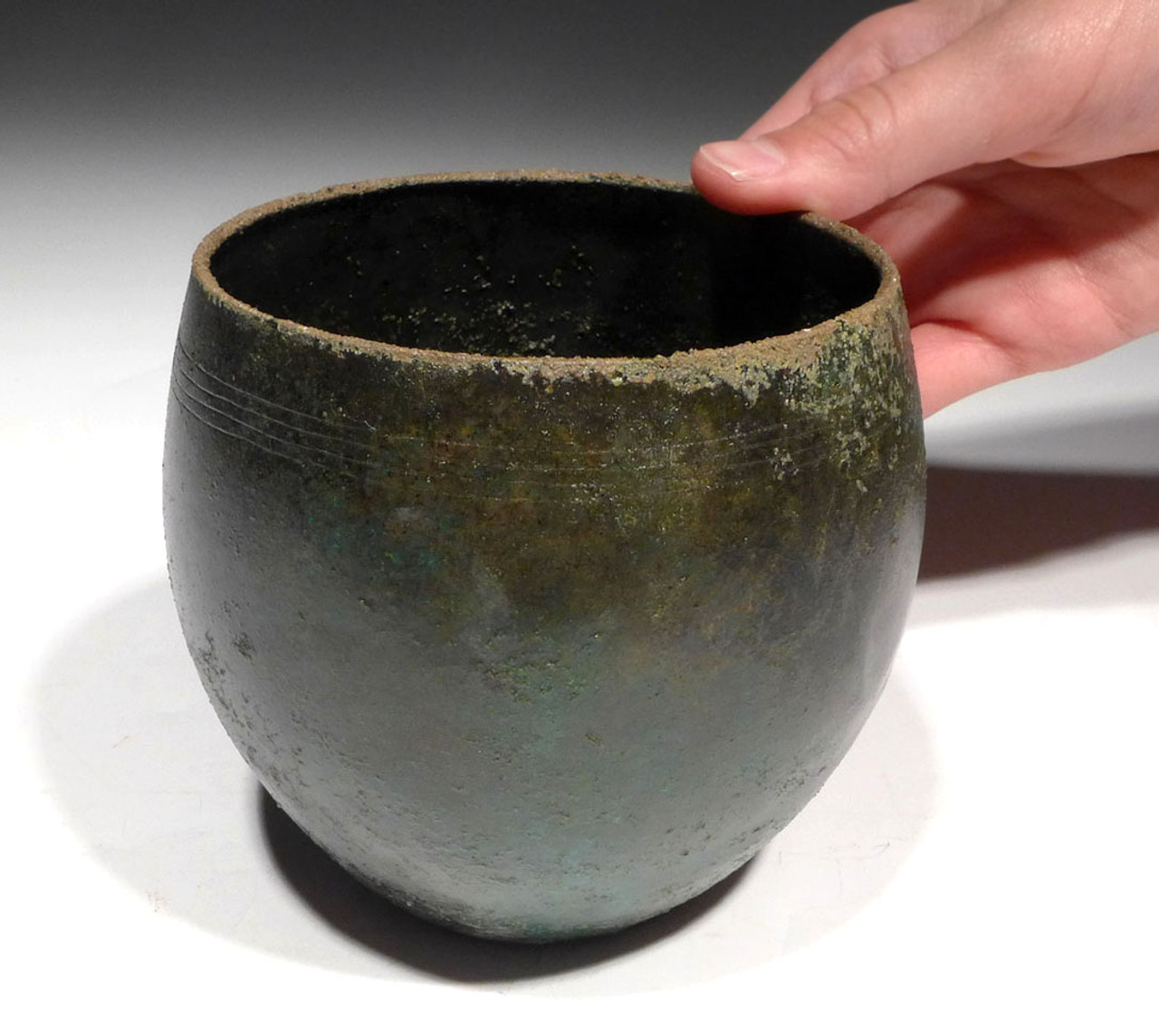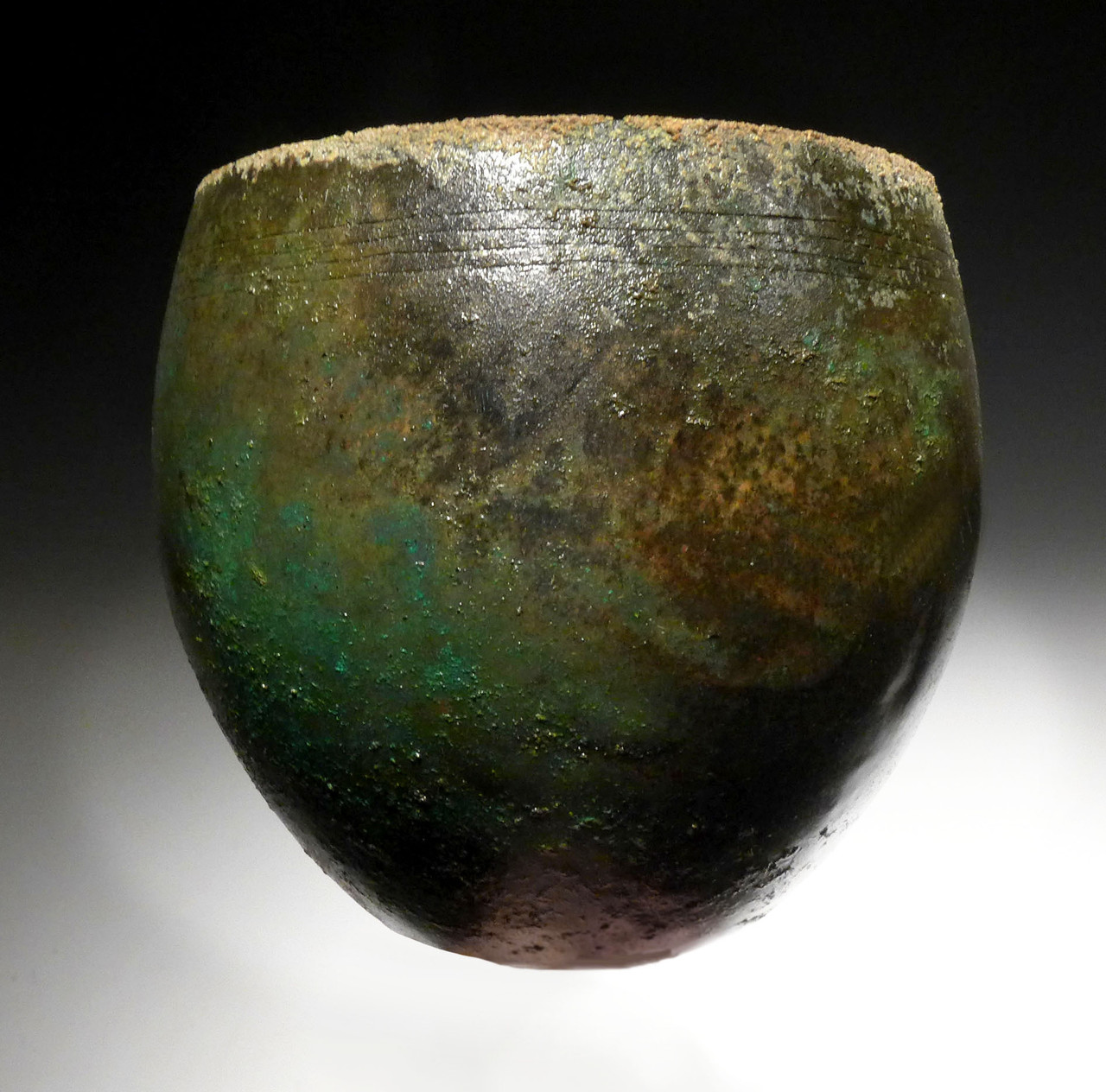Product Description
SEE MORE ANCIENT NEAR EASTERN LURISTAN ARTIFACTS
Compared to ancient ceramics which are much more durable and able to withstand burial for thousands of years, ancient bronze vessels are far more fragile and seldom survive the ravages of time. This is due not only because metal corrodes compared to ceramic which is stable, the thinness of metal vessels is far more delicate than the robust thickness of typical pottery. In ancient times, it was far more costly and time-consuming to cast or forge a bronze vessel than to knock out a clay one on a pottery wheel. All this contributes to the fact that ancient bronze vessels were exceedingly more rare than clay ones making this offering an especially important opportunity to add a rare ancient object of ritual and luxury to your collection.
With a stunningly rich-colored patina, aesthetic encrustations on its rim and perfect, complete intact preservation, you could not ask for a nicer ancient bronze urn vessel. This particular example comes from the ancient Near East Luristan age. It was used either as an important ceremonial object, or served as a luxurious vessel in an extremely opulent life of the highest, royal or noble class ancient citizen. It has four linear incised decorations around the circumference of the rim. The wide mouth and gently curved body terminates to a small flat base. Amazingly, there are no holes, cracks or missing portions. The light encrustations on the rim edge not only provide positive proof of age and authenticity, they add a mysterious and beautiful aesthetic to the vessel.
Such a piece would make a FANTASTIC accompanying specimen alongside tools and weapons to best demonstrate the aspects of this ancient life.
The patina shows beautiful traits only found in authentic ancient objects. It is a patina like this that the finest ancient bronzes are prized for and it is a patina like this that brings a premium in price and value of the specimen. A well-preserved and impressive object of utility and ritual from this famous Bronze Age culture.
NOTE: This artifact has been professionally cleaned and conserved in our lab, being treated with a special sealer. The patina shows beautiful traits only found in authentic ancient objects such as a layered mineralized patina with encrustations. There is no active bronze disease. Bronze disease can be a problem in bronze antiquities. Uncleaned and unconserved ancient bronze objects can corrode over time and eventually develop irreversible damage if not properly treated as we do with all our items offered for sale.
HISTORY
With origins dating back to prehistory, the empire of ancient Iran was one of the world's first superpower civilizations by the time it had taken form in the second millennium B.C.. The various cultures that can be included in the former ancient Iranian Empire stretched across an enormous geographical region extending beyond what is called the Iranian Plateau. To gain insight as to just how large this area was, the Iranian Plateau alone, includes Iran, Afghanistan and Pakistan and comprises approximately nearly 4 million square kilometers (almost 1.5 million square miles). The area of ancient Iran included not only the massive Iranian plateau made up of the tribes of the Medes, Persians, Bactrians and Parthians, but also included groups as far west as the Scythians (an eastern Scythian tribe existed in parallel in Central Asia), Sarmartians, Cimmerians and Alans populating the steppes north of the Black Sea. To the eastern boundary of the empire, the Saka tribes dominated, spreading as far as Xinjiang, China. From a very early period, the ancient Iranian peoples have been historically documented to exist in two separate continuums - a western civilization (Persia) and an eastern civilization (Scythia).
The beginnings of ancient Iran trace back to an influx into the Iranian cultural region of bands of horse-mounted steppe nomads from Central Asia, speaking Indo-European languages. Some settled in eastern Iran but other groups migrated deeper to the west settling in the Zagros Mountains. These first people descended from the proto-Iranians, originating from the Central Asian Bronze age culture of what is called the Bactria-Margiana Complex (aka Oxus Civilization), dated 2200-1700 B.C..
This historical achievements and the breadth of diverse cultures included of this once great empire are too vast to adequately credit in this brief synopsis. The Islamic conquest of Persia in the middle of the 7th century A.D. and the collapse of the Sassanid Empire marked the end of once geographically expansive and culturally diverse ancient superpower.
The term LURISTAN references artifacts made by a society of semi-nomadic people that once lived in the mountainous region of Northwest Iran. Little is known of this ancient culture but the most impressive traces are that of the bronze artifacts they left behind that can be found in parts of present-day Turkey, Iran and Afghanistan. These include highly decorative equipment for their horses, ceremonial containers and numerous weapons ranging from simple utilitarian pieces on up to elaborate masterpieces of warfare.
It is theorized that the Luristan bronzes were crafted by the earliest existence of the Median empire but this has never been proven as written records of the Medes have not survived. The Medes were Indo-Iranian people originally from central Asia who settled in Northwest Iran in the 9th century BC and later defeated the Assyrian empire in 614 BC. Their success is short-lived and their empire which once stretched from central Iran to the Persian Gulf and Anatolia was overrun in 550 BC by the Persians.
 US DOLLAR
US DOLLAR
 EURO
EURO
 AUSTRALIAN DOLLAR
AUSTRALIAN DOLLAR
 CANADIAN DOLLAR
CANADIAN DOLLAR
 POUND STERLING
POUND STERLING






















